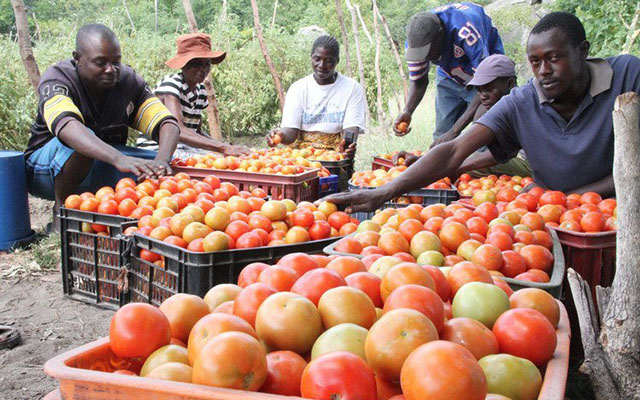
Farmers grade tomatoes after the harvest. This is the first step in the tomato puree production value chain
Dr Sanderson Abel
A value chain consists of a series of activities that add value to a final product, beginning with the production, continuing with the processing or elaborating of the final product, and ending with the marketing and sale to the consumer or end user.
For example the production of tomato puree involves small holder farmers in Mutoko or Mhondoro who produce the crop, transporters, wholesale fruiters (bulk traders) and manufacturers of tomato puree and tomato sauce, consumer goods wholesalers and retailers up to the end user of the product.
This would constitute a value chain since value is added at each and every stage. The inter-dependent linkages of the chain and the security of a market-driven demand for the final product can provide suppliers, producers, processors and marketing companies with more secure access to procurement and sale of products.
This reduces costs and risks of doing business and improves access to finance as well as other services needed by those within the value chain.
What is value chain finance?
Value chain finance is defined as the flow of funds to and from the various links within a value chain.
Stated another way, it is any or all of the financial services, products and support services flowing to and or through a value chain to address the needs and constraints of those involved in that chain, be it a need for finance, a need to secure sales, procure products, reduce risk and/or improve efficiency within the chain.
Value chain finance is a comprehensive approach which looks not only at the direct borrower but rather analyses the value chain and those within it, and their linkages in order to best structure financing according to those needs.
The linkages also allow financing to flow up and down the chain. For example, inputs can be provided to farmers and repaid directly from the sale of the product without having to go through a traditional loans process.
Access to adequate and timely financial services for all actors in the chain has proven a key element for success.
This implies that not only large producers and traders but also small producers need access to appropriate financial services to make optimal use of value addition and income generation.
What do value chain entail?
The ability to develop successful value chains in an economy has the potential to attract the development of various financial instruments.
These financial instruments can be used to fund the whole chain rather than individuals within the chain hence increasing the potential to increase output in the economy, and create more jobs.
Some of the financial instruments that can be developed at the back of value chains include various trade finance instruments, warehouse receipts, factoring, etc. and risk mitigation products related to the product such as forward contracts and guarantees.
Through the process of value chain financing, some sectors which usual find it difficult to get funding from the financial system can easily be resourced because of their links with other organisations with the value chain.
For example the financing problems currently faced by the informal sector players can also be easily resolved through strong linkages between the formal and the informal sector. Despite SMEs’ strong interest in credit, banks’ profit orientation may deter them from supplying credit to them because of the high transaction costs and risks involved but with linkages to the formal sector this can easily be resolved because the source of the risks can be addressed due to the links between the informal and the formal structures.
A closer look at the majority of what has is termed informal sector, one realises that these informal players are oftentimes the suppliers of the raw materials of the formal sector hence creating a value chain system.
It can also be shown that some of the informal sector players are currently involved in undertaking part of the production process of formal firms through subcontracting.
In this case the informal sector is part of the value chain because it’s contributing toward the production of the final product.
As long as the formal sector grows, and especially if it does competitively, then the informal sector will grow as well.
This growth also depends on the resources available, which can be difficult for the informal players to access but can easily be obtained by those in the formal sector.
One possible solution is that a deal can be struck where the formal player provides the guarantee for any amount borrowed by the informal player or alternatively funding can be advanced through the formal player who pays to the informal player for the work done.
Another area requiring urgent attention with regard to development of value chains is the agricultural sector.
It has been proven in most countries that strong agricultural value chains create sustainable livelihoods, increase incomes, and promote economic growth.
By supporting development of domestic industries, improving local markets, and expanding export opportunities, there is need for the stakeholders to allow all factors along the value chain, including farmers, input suppliers, wholesalers, transporters, food processors, and lending institutions to become viable partners in their countries’ economies, in order to generate employment, and improve food security.
- Dr Sanderson Abel is an Economist. He writes in his capacity as Senior Economist for the Bankers Association of Zimbabwe. For your valuable feedback and comments related to this article, he can be contacted on [email protected] or on numbers 04-744686 and 0772463008
